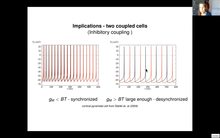The videos from Brain Day 2023 are now available on line at our youtube channel. Hope you enjoy.
Title: Modular architecture of the mouse visual cortex
Presenter: Andreas Burkhalter, Department of Neuroscience, Washington University School of Medicine
Summary: For many decades low-level visual perception was understood largely as constructive process along the afferent visual pathway into deeper parts of the brain, in which increasingly abstract features are encoded from the bottom-up. Despite the success of deep learning feedforward networks (Kar et al., 2019), reconstructing the visual world from feature selective receptive fields is only part of the process. More recently, equal importance has been assigned to feedback connections from higher to lower areas of the cortex (Vezoli et al., 2021). Increasingly perception is understood as an inferential process, whose goal it is to resolve ambiguous sensory evidence(Bastos et al., 2015). In this process inputs are interpreted based on prior experience stored in the brain. Thus, dysfunctions of the circuits which integrate bottom-up and top-down information may underlie hallucinations, delusions, psychosis and schizophrenia (Leptourgos and Corlett, 2020).
To understand the underlying network it is insufficient to track the transformation of neuronal responses along the pathway. Rather, we need to know how multiple parts of the brain interact with inputs from the outside world. To do this, we have to track activity from large numbers of cells under different behavioral conditions. While this is feasible by calcium imaging or array recordings in mice, interpreting patterns of activity requires knowledge of the underlying architecture of the cortical network, which is incompletely understood. Additionally, mouse visual cortex is thought to be non-columnar (Ohki et al., 2005) and different from primates, which complicates generalizations. Our observations of the modular expression of m2 muscarinic acetylcholine receptor in layer 1 of mouse primary visual cortex has challenged this view (Ji et al.,2015; D’Souza et al., 2019). Layer 1 is the cell sparse outermost layer of cortex, prominent target of dendrites of pyramidal cells of the layers below as well as inputs from higher sensory and motor areas. Thus, it has been proposed that layer 1 is a key site for long-term plasticity and learning (Shin et al., 2021).
I will present anatomical and physiological data that are consistent with a modular organization of the generative hierarchical network of mouse visual cortex. The results show that different modules form like-to-like intracortical feedforward/feedback recurrent loops. The loops are only partially associated with dorsal and ventral processing streams (Wang et al., 2012), but subdivide the dorsal stream into two anatomically distinct sub-streams. The modular loops have distinct spatiotemporal sensitivities and are differentially modulated by the context of self-motion.
From these result we conclude that the modular architecture of mouse visual cortex organizes a distributed hierarchical network for processing information about shape, optic flow and locomotion, designed for object recognition, egocentric path integration and allocentric map based navigation.







